The Garden Professors test new products all the time. Fertilizers, pesticides, tree wraps,compost tea, etc., they’ve all found their way into our fields and greenhouses at one time or another, but still, we can’t test everything, it’s just not possible. New stuff comes out all the time, and it’s impossible to keep up, so one of the things we love to see is people who take the initiative to test things themselves. Recently we got to see the results from a group of Master Gardeners who tested biochar on growing vegetables. The results aren’t final yet – there’s still a few years to go – but I love the fact that this is occurring and I can’t wait to see more.
Long winter proves that climate change is a hoax
Just looked at the forecast for the week – Thursday’s forecast high temperature is 32 deg. F. This is a far cry from last year’s record-shattering 86 on the same date. Clearly all this blabbering about climate change is just a bunch of hysterical nonsense.

As sportscaster Lee Corso would say, “Not so fast, my friend…” While winter 2013 can’t compete with winter 2012 in terms of record-breaking warmth, this winter has continued a trend which may have profound implications for landscape and garden plant selections.
As you’ll recall, last winter saw the release of a new USDA Hardiness zone map which indicated that most areas of the US had warmed by at least one-half hardiness zone (5 deg. F) since the previous map was produced 22 years earlier. Hardiness zones are based on average minimum temperatures; in other words, what’s the coldest temperature you’re likely to see in a given winter. As it turns out, minimum temperatures have been warming faster than overall average temperatures. So much so, in fact, that one researcher declared the brand new hardiness map dead on arrival. Nir Krakauer at City College in New York noted that if we look at trends, rather than averages, many areas of the US are already another half a zone warmer than the new USDA map.

Minimum winter temperatures are warming at a much faster rate that average temperatures
Last week I gave a presentation at the Minnesota Shade Tree Shortcourse and pulled together some cold hardiness data for the Twin cities. According to the new USDA map, Minneapolis-St. Paul is now zone 4b (-25 to -20 deg. F). One way to think of this over a long enough time-span, about 1/3rd of their winters should reach a low in that range, 1/3rd should be slightly warmer, and 1/3rd should be slightly colder.
The new USDA map indicates the Twin cities are in zone 4b
I pulled out the winter weather records for Minneapolis-St. Paul since 2000, including winter 2013. In the past 14 winters temperatures in the Twin cities have dipped to their hardiness zone level exactly once, 2004. All other minimum temps were at least 5 deg. F warmer.

Annual minimum temperatures at Minneapolis-St. Paul airport (MSP) have reached zone 4b levels only once since 2000.
Obviously a 14 year record is not sufficient to build a hardiness map. Nevertheless, if someone tries to use this winter as proof that climate change is hoax; just remember, minimum winter temperatures – the temperatures that serve as a primary limit of which plants can grow where – tell a different story.
The End (hopefully) of Molasses Malarkey
I’ve been discussing the purported insecticidal properties of molasses in my last couple of posts. I’m hoping this will be the final nail in the coffin (or stopper in the bottle):
Here’s the end of the original blog piece linked above:
“Microbial bloom and Fire Ants
“These two things seem unrelated. Microbes and specifically bacteria consume simple sugars (which is why your momma made you brush your teeth). When soil born microbes are exposed to simple sugars, their numbers can double in just 30 minutes. As microbes go through their life cycle, they add organic matter and micro nutrients to the soil, improving the soil and making nutrients more available to your plants. Regularly applying molasses to your soil and plants greatly improves the quality of the soil over time. Soils with high microbial activity are easier to dig in and stay moist longer.”
I’m actually going to leave this paragraph alone, since it’s relatively accurate (except for the sentence about applying molasses to your plants, which I dealt with in my first post). Let’s move on:
“So, about the Fire Ants…since it seems that the big universities can’t make money studying the effects of molasses on Fire Ants…they don’t do any research on the subject. But, it has been proven that molasses makes Fire Ants pack up their mound and migrate to your neighbor’s yard. It may be that the bloom of microbes, irritates the little stinkers. It could be that they are running from a specific microbe. It could be that they just hate sugar (they eat mostly protein which is why you can turn a greasy over baked pan upside down over a Fire Ant mound and they will clean it for you). What ever the reason, applying molasses to your yard makes them leave.”
This entire paragraph is nonsense, beginning with equating grease with protein (it’s a fat) and ending with the supposed lack of research on fire ants. There’s a LOT of research on fire ants; pest studies are very well funded. Out of the 1500+ articles I pulled up on fire ants in the Agricola database, only one includes molasses. And that’s in a 1986 study comparing different kinds of baits (“Comparison of baits for monitoring foraging activity of the red imported fire ant (Hymenoptera: Formicidae)”), where molasses was found to be more attractive to fire ants than peanut oil. How this translates to “molasses makes Fire Ants pack up their mound and migrate to your neighbor’s yard” I’m not quite sure.
“If you’re crunched for time and money, molasses is the answer to a lot of your gardening problems. The benefits are undeniable, your yard will smell great and you get to feel good about letting your kids and pets play in the yard. Whether you choose dry molasses (applied to soy chaff) or the liquid (which is cheaper to use), molasses is the single best thing you can do for your soil and plants.”
The typical snake-oil pitch! (For a completely unrelated but accurate and amusing example of an old-time snake-oil pitch, check this link. You’ll see the similarities).
“It was brought to my attention that I forgot to add this info. (It is hard to remember everything when you are trying to rule the world!) During moquito weather mix:
- 3 tbsp molasses
- 1 tbsp Liquid Garlic (a deterent and has some fungicidal properties)
- 1 tbsp liquid organic fertilizer of your choice (seaweed, fish emulsion, etc) into 1 gallon of water
Spray with abandon, every week if necessary but it may last up to 2 weeks if we don’t get much rain. This also works like a charm on lace bugs on azaleas and lantana.”
Spray with abandon???? This has to be one of the most reckless pieces of advice I’ve ever read. Whether it’s a fertilizer or (more importantly) a pesticide, it should *never* be applied lavishly. (Though this is such a dilute solution that it probably isn’t much different than water.)
This topic has made me crave the molasses popcorn balls my grandmother used to make. Anyone have a recipe for those?
Powers of the Mind
A couple of days ago I read a journal article which seemed to show that certain individuals could, using some sort of mind powers, called biofield treatments, influence the growth of plants. You can read the article here.
In case you were wondering what goes through my mind when I read something like this, let me tell you: The first thing that enters my head are skeptical thoughts. I try to get rid of these quickly though, because I believe that, as a scientist, it is my job to critically evaluate the science behind the paper without letting my own preconceived notions influence me. It’s also important to remember when reading a paper like this, which challenges preconceived notions, that this paper has gone through a significant review process. This process does not guarantee that the paper is perfect, but it does mean that some other scientists somewhere have concluded that the paper is worth something.
OK, so now you know what goes through my head. Next question, after reading the paper am I convinced that powers of the mind can actually make plants grow bigger and have greater yields? The simple answer is no. There are a lot of things that are going on here that are just odd and which raise questions, and without answers to these questions I find it difficult to believe that everything is occurring exactly as indicated in the article. Yes, something appears to be going on, but whether it is due to “biofield treatments” isn’t clear. To begin with, I’d like to have soil tests showing the nutrient status of the soil prior to the experiments. I’d also like to see a nutrient analysis of the foliage of the plants at the conclusion of the experiment. It is odd to have added the nutrients that the researchers added to test plots and to see no effect – unless a biofield treatment was used. It also seemed odd to me that plants wilted when there was drip irrigation there. And it seemed odd that the fertilizers used weren’t described better. There were other things I was interested in knowing too, but I won’t bore you.
Another thing I noticed is that one of the authors of the article is actually a member of the foundation which paid for the research to be conducted — and is, in fact, the corresponding author (in other words, the author who you should contact should you have any questions). This isn’t “against the law” or anything, but it is odd.
As a scientist it is my responsibility to acknowledge the possibility that these biofield treatments had some effect on plant growth, but to actually convince me that they did you need to write an article that is rock solid with no opportunity to say “But what about….”. Right now this paper just doesn’t do that. Too many odd things going on.
Garden Professors on the Mike Nowak show
Last Sunday Jeff Gillman and I were guests on Mike Nowak’s Chicago-based gardening show. It’s now linked up, so check it out if you feel so inclined!
There’s been discussion on Facebook as well, primarily about (you guessed it) compost tea. (You’ll need to find the #gardenchat group and scroll down to Mike’s posting to see the lively discussion.)
Must we continue to bring in exotics?
A couple weeks back I posted about a collaborative research project that I am involved with to identify seed sources of two Mediterranean fir species (Turkish fir and Trojan fir) for use as Christmas trees in various locations around the country. The post prompted a question from Monta Zengerle who asked, “Must we continue to bring in exotics to satisfy the nursery trade?” Since our intended purpose is Christmas trees and people move plants around the world for purposes other than nursery stock, I’ve broadened the question to “Must we continue to bring in exotics?” for this discussion.

Not all exotic species introductions are man caused. This dock washed ashore in Oregon following the Japanese tsunami carrying all kinds of critters with it.
The answer, of course, is “No.” As human beings the only things we absolutely have to do are eat, sleep, and breathe. But the reality is much of the food and fiber production around the world, as well as our amenity plantings, are based on exotics plants. Human agricultural history is largely the story of plant importation and subsequent breeding. As Thomas Jefferson famously observed, “The greatest service which can be rendered any country is to add a useful plant to its culture.” However, it is doubtful that Jefferson considered kudzu or purple loosetrife could be among those plants added to our culture. Today we have a different understanding and realize that along with the economic benefits of plant exploration and importation comes the possibility of unintended and serious ecological consequences. And we’ve realized this for some time. People that deal with plant introductions on a regular basis talk about ecological errors and economic errors. If we allow importation of a plant that later turns out to be ‘bad actor’, we’ve made an ecologically harmful decision; if we ban a useful plant that ultimately would have turned out to be non-invasive, we’ve suffered an economic loss. Fortunately, only a small percentage of exotic species become naturalized and only small percentage of naturalized species become invasive. The underlying challenge is we cannot predict with 100% certainty which plants will be invasive in a new environment and which won’t. Ecologists are working on it and we can certainly begin to judge the invasive potential of new introductions. In the meantime, we are left with the imperfect calculation of whether the potential economic upside outweighs any potential environmental risk.
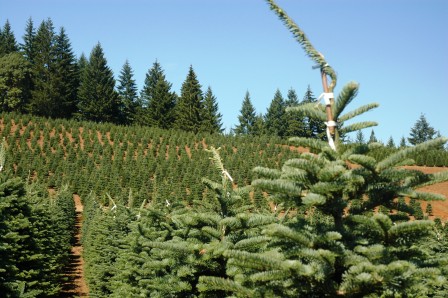
‘Top-work’ on noble fir in Oregon to maintain a single terminal leader. Turkish fir typically require less top-work.
So let’s look at our current project as a case study. What’s the upside? Christmas tree growers in the U.S. produce roughly 20 million trees annually. That’s a potential economic impact of hundreds of millions of dollars and seasonal and full-time employment for workers on over 13,000 farms from North Carolina to Washington State. A major issue for growers in virtually all of the principle growing regions is phytophthora root rot. Previous work at Oregon State University indicates that Turkish fir is highly resistant to this pathogen. By identifying seed sources with phytophthora resistance and superior Christmas tree characteristics (tree form, needle color, post-harvest needle retention), we will enable growers to continue or expand production and give consumers an additional choice for their holiday tree.
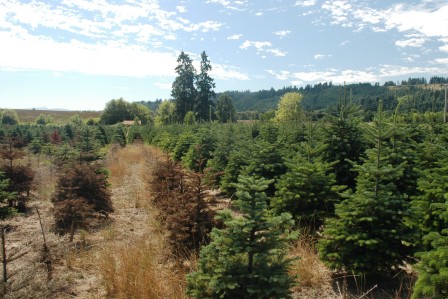
Native noble fir (left) is highly susceptible to root rot. Turkish fir (right) is much more resistant.
What’s the down side? As I mentioned, predicting invasiveness is difficult. That said, firs have several characteristics that make them unlikely invaders. Most firs have a relatively long juvenility period (age before they produce seed) which means they have a long period between generations. Secondly, most fir species produce seed crops sporadically as opposed to producing heavy seed crops year after year. Ecologically, firs are pretty wim
py; growing best on moisture, well-drained sites and unlikely to aggressively colonize disturbed areas. Lastly, the best predictor of invasiveness is invasiveness – a plant that has become invasive in one location is a candidate to become a repeat offender in a similar environment. Among conifers, the greatest issues with invasives have been pines (genus Pinus), in the southern hemisphere. In fact, all of the documented cases of invasives in the pine family (Pinaceae) are Pinus species; none were Abies. Based on all this, the likelihood of Turkish fir or Trojan fir becoming ecological problems appears very small, while the potential to add a useful plant to our culture is clear.

Exotic giant sequoias at Hoyt arboretum, Portland, OR.
Richardson, D.M. and Rejmánek. 2004. Conifers as invasive aliens: a global survey and predictive framework. Diversity and Distributions 10:321-331.
Rime and Reason
This weekend I got to take a leisurely drive to the northern end of Michigan’s Upper Peninsula with my daughter so she could check out Michigan Tech University. Lots to see along the 488 mile drive from DeWitt to Houghton, including a moose, lots of snowmobiles, and the world famous ‘Yooper tourist trap’. (For the uninitiated, people that live in the U.P. are known as Yooper’s, while those of us that live beneath the Mackinac Bridge are known as ‘Trolls’) Once we got along the Lake Superior side of the U.P. we drove through a short section of freezing fog that produced rime on the surrounding forest. Our tight schedule and road conditions prevented me from stopping to get photos but I found several on Wikimedia commons that illustrate the phenomenon.
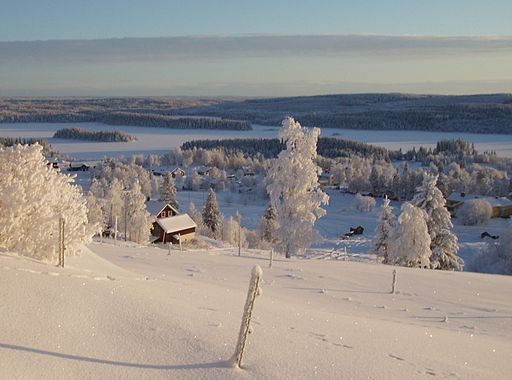

Here’s a recent TV weather blog that provides some additional photos and information rime and hoar frost, which is a related winter weather phenomenon. Rime forms when air temperatures are below freezing drop below the dew point as the water condenses and freezes, the ice crystals accumulate on the windward side of trees, fences, and other objects. Another similar phenomenon is hoar frost. Hoar frost looks similar to rime but is lighter and not associated with freezing fog. It forms when surfaces cool below the dew point and ice crystals accumulate. Here are some examples of hoar frost we experienced a couple years ago here at MSU.
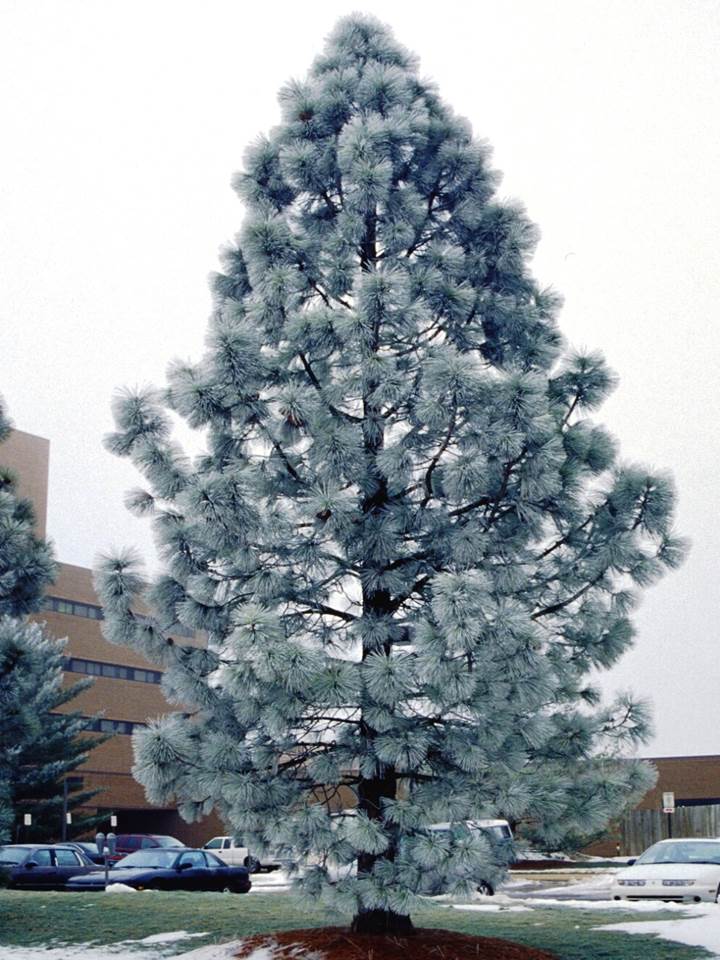
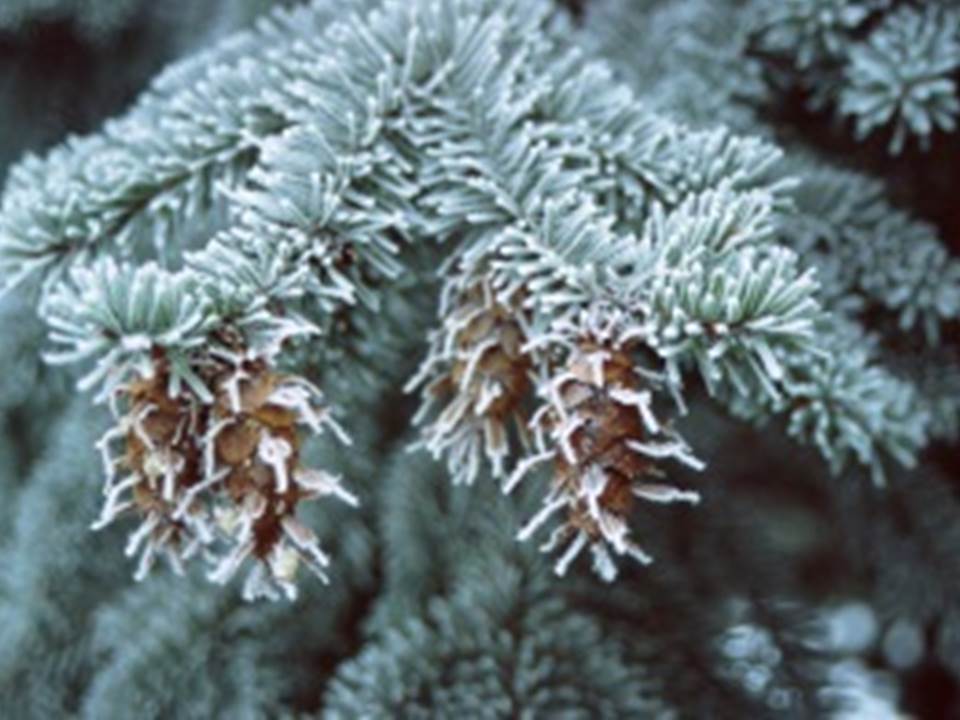
Advice needed – quick!
Monday’s not my usual day to post, but I need your help.
I’m to present at a large garden symposium next week. You know the usual syposium format: there’s a design talk, one on plant care, another on edibles in the landscape, and finally the plant-lust generating presentation (The Plant Talk). That’s my role in this particular symposium. My topic is very broad – new and underused annuals, perennials, and woodies. Actually, it’s too broad, and it’s giving me fits.
Now, I’ve both given and sat through countless Plant Talks as I’m sure you have (and many of you have probably delivered said presentations). I will say I know to limit my list, as hard as that is (only one hour to present). Giant
lists can become mind-numbing, especially when little info is given
other than "Wow, look at this variegated foliage! Love it!"
My issue is how to best arrange this disparate group of plants so that it makes the most sense to my audience. Currently, they’re grouped by plant type (perennial, annual, woody, ornamental grasses etc.) and alphabetically within. But I’m having second thoughts.
How you can help: think back to the most useful and efficient presentations you’ve heard…how were they organized? As I have them (by type)? Season of interest (spring blooming, fall color, etc.)? Sun or shade? Alphabetically? Other? Eh?
Please weigh in!
The Winter Weekend Garden Warrior
As Garden Professors, we are very careful regarding product endorsements. Actually, much energy is spent trying to bring to light weird/crappy/useless/money-wasting gardening products.
But when we feel strongly about the usefulness, quality, and utility of a product, it is our duty to pass that information along as well.
I didn’t mean to be a walking advertisement last weekend.
We were in the final throes of getting our garden cut back; Joel was laughing that I “needed another set of hands” when I came around the corner. “Not with my fabulous Firehose Work Pants from Duluth Trading Company, I don’t!” Thus the inspiration for this post.
All products noted are, variously: warm, waterproof, full of pockets, sharp, indestructible, dependable, and/or delicious.

Good Stuff
Boy oh boy, what a fun day! People yelling at me from the left and from the right. But hey, I didn’t start doing what I do to make everyone happy. With that said….Nah, I don’t feel like attacking anyone today. Instead, let’s look at a good renewable fertilizer: Cotton seed meal. It’s got a reasonably good ratio of nitrogen to phosphorus and potassium — slow release of course. Basically a waste product given a meaningful purpose. And look at the label — no mycorrhizae or other gimmicks. Just pure, unadulterated, cotton seed meal. This is what I want on my garden.
